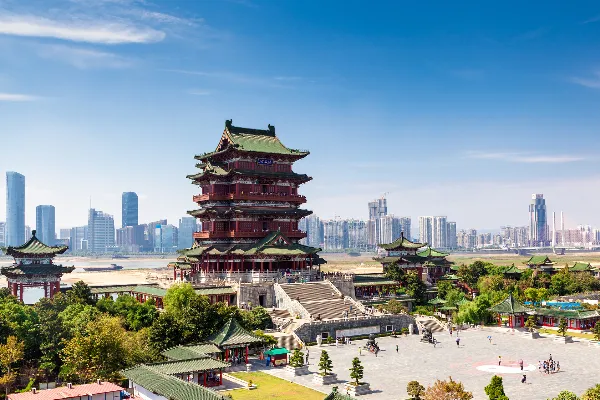
Tengwang Pavilion Scenic Area is located by the Gan River in Donghu District, Nanchang City, Jiangxi Province. It is a national 5A-level tourist attraction and a key cultural relic protection unit. Covering 4.3 hectares, the main structure Tengwang Pavilion stands 57.5 meters high with nine floors and a construction area of 13,000 square meters. Known as one of the "Three Great Towers of Jiangnan" alongside Yellow Crane Tower in Hubei and Yueyang Tower in Hunan, it gained fame through the Tang Dynasty poet Wang Bo's "Preface to Tengwang Pavilion" and serves as Nanchang's cultural landmark.
History and Culture
Originally built in 653 AD during Emperor Gaozong of Tang's reign by Li Yuanying (Prince Teng), the pavilion has been destroyed and rebuilt 29 times over its 1,300-year history. The current structure, reconstructed in 1989 based on Liang Sicheng's design, symbolizes Chinese culture and witnesses Nanchang's millennium-old cultural heritage.
In 675 AD, young poet Wang Bo spontaneously composed "Preface to Tengwang Pavilion" during a banquet, with the famous line "Sunset clouds fly with a lonely duck; Autumn water shares the same color with the vast sky" becoming an eternal masterpiece. Subsequent generations of literati left numerous poems here, making the pavilion an important cultural carrier. It now displays precious calligraphy, paintings, and stone inscriptions.
The pavilion features exquisite architecture with "three visible and seven hidden" floors - appearing as three stories with corridors externally but actually having seven interior levels. Multiple exhibition halls systematically present its history and cultural significance. The panoramic Gan River view from the top is breathtaking.
Main Attractions
Main Pavilion
The 57.5-meter-high main pavilion adopts Song Dynasty architectural style with green tiles and red pillars. The first floor introduces its history; the second showcases Jiangxi's historical figures; the third displays local customs; the fourth exhibits cultural relics; the fifth offers river views; and upper floors house equipment. An elevator facilitates access.
Preface Stone Tablet
This 3m×8m tablet on the first floor bears the complete "Preface to Tengwang Pavilion" in calligrapher Qi Gong's handwriting. Describing the pavilion's grandeur and Hongdu's prosperity while expressing the author's unrealized talent, it's acclaimed as "the best parallel prose in the world".
Tengwang Square
The 15,000-square-meter square hosts cultural events with a central musical fountain and lush greenery. Lit beautifully at night, it's popular for leisure activities. Traditional lantern festivals are held here during Spring Festival.
Gan River Scenic Belt
This 2km riverside area features viewing platforms and walkways. The pavilion and Gan River Bridge create magnificent scenery, especially when illuminated at night. Boat tours depart from the pier.
Nanchang Museum
Located within the scenic area, this 12,000-square-meter museum displays over 50,000 artifacts including bronzes, ceramics, and paintings, systematically presenting Nanchang's history from Neolithic times. The Haihunhou Tomb artifacts exhibition is particularly remarkable.
Cuisine
Nanchang Mixed Rice Noodles
A local breakfast staple, these quality rice noodles are served with peanuts, pickled radish, scallions and special sauce. Several time-honored noodle shops near the scenic area offer authentic flavors.
Earthen Pot Soup
This traditional dish simmers ingredients in special pots over charcoal for hours. Varieties include egg-meatloaf and kelp-pork rib soups. Scenic area restaurants serve authentic versions.
White Sugar Cake
These traditional glutinous rice cakes coated with sugar and sesame are sweet and chewy. Street vendors near the scenic area sell this popular snack.
Nearby Cuisine
Nanchang also offers specialties like stir-fried artemisia with bacon, Poyang Lake whitebait, and three-cup chicken. Visitors can explore food streets like Zhongshan Road after touring the pavilion.
Ticket Information
Admission is 50 yuan (half-price for students/seniors), including main pavilion and museum access. Opening hours: 8:00-18:00 (peak season April-October), 8:30-17:30 (off season). Night opening times announced separately.
Recommended Itinerary
Suggested route: Visit the main pavilion in morning; lunch on local specialties; afternoon museum tour; evening riverside walk for night views. With more time, take a night cruise to experience the poetic scenery described in Wang Bo's preface.
Transportation
- Airplane: About 25km from Nanchang Changbei International Airport (40-minute taxi)
- Subway: Line 1 to Tengwang Pavilion Station
- Bus: Routes 2, 26, 38 to Tengwang Pavilion stop
- Driving: Parking available onsite
Must-see Attractions
- Main Pavilion: 57.5m Jiangnan landmark with river views
- Preface Tablet: Inscribed masterpiece by Wang Bo in Qi Gong's calligraphy
- Gan River Scenic Belt: Stunning pavilion-bridge nightscape
- Nanchang Museum: Haihunhou Tomb artifacts highlight
- Tengwang Square: Cultural activities and musical fountain
Travel Tips
- Best seasons: Spring and autumn
- Suggested duration: Half to full day
- Familiarize with "Preface" background beforehand
- Be cautious when climbing crowded stairs
- Don't miss night illuminations
- Consider booking professional guide service
Precautions
- Protect cultural relics - no carving
- No pets allowed
- Secure personal belongings
- Wear life jackets when boating
- Walk carefully on rainy days
- Be considerate when taking photos